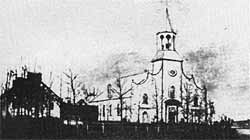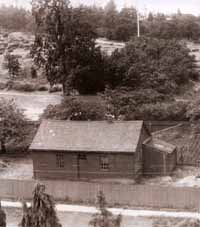|
|
The final blow to the Blondin's was the destruction of the homestead by fire. One day they had gone away for only a few hours, and when they returned, everything was ruined. The fields, granaries, orchards and house were all smoldering ruins! The old couple were offered a home with their son, Jean Baptiste, in Beauharnois. As usual, this trial was accepted as a blessing in disguise from the good God, and they made the best they could of their new situation. They knew that God would provide, as He always did, and conformed themselves to His holy will. Even with her many crosses, Mrs. Blondin remained cheerful and entertaining. In her son's home she became young again with her grandchildren. And as with her own children, she taught them to love Christ crucified and to see Jesus in the poor. She also sang to them, taught them games, and danced with them—and they loved her for it.
|
|||||||||||||||||||||||||||||||||||||||||||||||||||
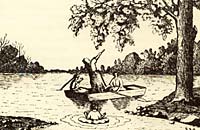 |
|
Esther
Floating on the Stream |
|
Our saint inherited her mother's love for prayer. As soon as she could lisp, she was taught the Sign of the Cross and the little prayers that Catholic children learn. Having said her few prayers, the little girl would then remain on her knees or nestle in her mother's arms during the long prayers said by her mother, father, and older brother. Esther was very attentive to their prayers and one evening, when she was less then 4 years old, she surprised the family by saying the Our Father, the Hail Mary, The Creed, the Confiteor, and the Ten Commandments. God was certainly working with her little soul and in time it would flower and bear fruit.
Even as a little girl, Esther was known for her charity. One day she was at her neighbor's house when an old man came to the door. As was the custom for beggars, he pleaded, "Charity for the love of God!" The girl explained that it was not her home but that she would go and ask the owner in the backyard. Then she added, "But first let me wipe your face and give you a drink, for you look hot and tired." The man accepted the little girl's hospitality and then she went for the owner. But when they came back the old man had disappeared. The neighbors were questioned and no one had seen the old man, nor had a person fitting this description ever been seen. One can only wonder if Our Lord Himself; in the guise of another person, had appeared to the little girl and allowed her to perform her little act of charity, like Veronica, from the Stations of the Cross!
Special Trials
When Esther was 12 years old, she was more pious and refined than girls who were teenagers. At this time God started to prepare the girl's soul for a greater work—He placed her on the royal road of the cross; the cross of interior suffering. Suddenly the poor child was plunged into unaccountable depression. The world appeared to her as a vast snare, set with decoys to entrap virtue. And the thought of the judgment of God filled her with terror. Overwhelmed with the consideration of the eternal truths, and the sufferings of Christ crucified, Esther sought solitude. Though she was surrounded by all that was pleasant, she lived in retirement—she meditated, wept, and did penance. She slept on the floor, and fasted; and through a desire for suffering, she burned her flesh with the flame of a candle.
Mr. and Mrs. Blondin observed their daughter's changed conduct with tenderness. Her mother called her the "saint" of the family, and she and her husband left Esther free to follow the inspirations of the Holy Ghost. The trial lasted until she was 15. During this ordeal, the poor girl had recourse to prayer, especially the rosary. She made visits to the Blessed Sacrament and received Communion as often as she was allowed to, at that time. This trial made a deep impression upon her and she would benefit from it later in her life.
The devil saw that Esther was gaining victory over him, so he tried one of his most cunning tactics—a tactic which seldom fails! The girl was now 16; people commented on her pleasing features, she had dreamy brown eyes and the dignity of her carriage stressed the poise of her character. People in the world showed their love for her, and she in turn became lured by the world—she wanted to be merry with the merry. She joined in the festivities, the parties, the dances.
The Sisters of Notre Dame
However, this did not last too long and in 1826, God opened a new door for Esther, before she became a worldly woman. The pious girl registered as a boarder in Terrebonne, with the Sisters of the Congregation of Notre Dame, founded by St. Marguerite Bourgeoys, in 1657. Her intention was to further her rural education and prepare herself for the teaching profession.
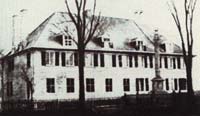 |
|
| Convent
of the Congregation at Terrebonne, 1826 |
In the convent school, our saint was an honor pupil. Besides her perfect behavior as a senior boarder, she won favor through her tact, good humor, and sense of justice. During this time, one of her classmates who was jealous of her, complained that Esther was better than the rest of the pupils because she was older. But one of the nuns said that Esther; "is better because she is one of God's chosen souls."
After spending two years in the convent, the nuns realized more and more, that Esther had genuine virtue, and the girl herself, realized the excellence of the religious life. When she asked to be admitted to the Congregation of Notre Dame, the nuns welcomed her with open arms.
Novices have much to learn; for instance that they are not to do more than the rule prescribes, even in good works, such as inflicting bodily pain. Not knowing this, our saint continued the penitential practices of her former life, and even added to them. It is true that prayer and mortification go hand in hand on the narrow road to heaven, but they must be wisely directed. Perhaps God permitted these well meant mistakes on the part of Esther, in order that she would use prudence in guiding her spiritual charges in the future. Rising early, for many religious, is a lifelong effort and even after forty years of conventional rule, our saint admitted that she had to overcome herself every morning, to obey the rising bell that calls the community to action, hours before the rest of the world is astir.
In due time, our friend was clothed with the holy habit of the Sisters of Notre Dame, and received the name of Sister St. Christine. The holy woman pursued her duties in this advanced step with great fervor but before long the health of the fervent novice declined. The Sisters of Notre Dame were reluctant to dismiss such a good Novice, so they sent her to one of their country convents, hoping that a change would bring her back to good health—but it did not.
Towards the end of her novitiate, Esther was forced back into the world. With great sorrow she removed her habit and resumed her secular dress. Her favorite brother, Jean-Baptiste, who came to take her home, begged the Sisters of Notre Dame to keep Esther—but to no avail; it was God's holy will that the young woman should leave. In his later years, Jean-Baptiste often remarked, "Little did I know on that sad day, when my heart ached so at seeing my sister's grief in leaving the convent, what great things God was preparing for her."
One day in 1833, two Sisters of Notre Dame, on their way from one convent to another, had to stop overnight in the village of Vaudreuil. They knew that Suzanne Pineault, a former Novice of their community, kept a boarding and day school there, and to her they went for hospitality. The young teacher was delighted to receive the sisters, and when speaking to them about her work, she said it was becoming too much for one person. Miss Pineault asked the sisters if they knew of some lady whom they could recommend as an assistant to her.
The sisters told her, "An excellent woman has been obliged to leave our Novitiate on account of ill health—Miss Esther Blondin. She is particularly suited for teaching. She has written that her year at home has been beneficial, and she feels fit for some kind of employment. We know you would be most congenial."
A Teacher
The two young ladies became very close friends. But little did they think that when they met as principal and assistant, that they would be linked in adding a religious community to those recorded in the history of the Catholic Church. And a few years after their association in the Vaudreuil school, the two ladies were united by an even stronger bond of friendship. Suzanne's younger sister and Jean Baptiste Blondin were visiting the two teachers, and happened to meet in the parlor—in time marriage was the end result.
The two teachers conducted their school together for six years, and then Suzanne withdrew to stay with her uncle who was pastor of the parish at St. Timothy. He had often asked her to come and take management of his priory, and supervise his school.
Esther continued with the school at Vaudreuil. She had great vision and visited the schools in the cities of Quebec, Montreal, and "Bytown"—now called Ottawa. She engaged a teacher for English, and one for music, and hired servants for the housework. In those years this was a major achievement being that many places were still quite primitive. The Vaudreuil school was ably conducted, and its students, because of their neat becoming attire and faultless deportment, drew forth many favorable comments from the people of Vaudreuil. They spoke in glowing terms of Miss Blondin, the principal of the school.
Esther's talents were not only confined to the activities of her school. She became the centre of Catholic Action. The parish priest could rely on her zeal and her profound effective piety. And in 1843, when the guild of the Children of Mary was organized, our saint was elected as its first president. When the pastor could not attend the meetings, she was put in charge, and she instilled into the members; love of prayer, love for Mary, love for the Blessed Sacrament, and an active charity—such as visiting the sick, the aged, the infirm, and almsgiving.
A Great Project
After fifteen years of teaching, blended with social action, Esther thought of aspiring to higher ideals. She believed it was God's will to found a religious community for the education of poor country children, both girls and boys in the same classroom, and for the care of the sick. This idea of teaching both girls and boys in the same classroom was viewed as subversive and contrary to the principles of sound morality, because the customs of the day allowed that only women would teach girls and that men would teach boys; and girls and boys studying in the same classroom was forbidden.
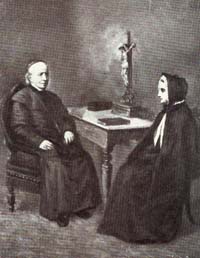 |
|
| Mother
Mary Anne consulting Bishop Bourget |
However, at the same time, though Quebec had developed into a civilized area; with nuns and priests guiding the people, it was impossible to get enough men or women to teach girls and boys in separate schools, especially in the country areas. Unable to afford two separate schools, many parish priests chose to have none. It would also have been quite an expense and a great inconvenience to send, especially the older boys, to other towns, just so they could be in a same sex school. Farming, cutting trees, or country work, were the main occupations of many of the country people and the older children were much needed at home, before and after school. As it was, many of the poor children were not even going to school, if there was none in the area.
As Esther prayed for courage and light, the impulse became more insistent. At last during Lent of 1848, God granted her prayer. Now she knew that first, she must submit her ideas to Bishop Bourget, the Bishop of the diocese, and second, she must get a letter of introduction from her pastor, Fr. Archambault.
The pastor wrote the letter to the Bishop on June 11, 1848, and before long Esther journeyed to Montreal to see Bishop Bourget. When the Bishop entered the parlor, the young woman knelt for his blessing and soon poured out her story to the good Prelate. He listened attentively and raised no objections to Esther's project. Then he said, "I will think it over; meanwhile, you pray and wait."
To this our saint exclaimed, "I have prayed, oh so much, and so long; and if it weren't for prayer, I could not have presented myself before Your Lordship with this mission!"
The good Bishop was won over by Esther's stalwart answer. "You may try. Mention your project to companions whom you think likely to join the undertaking. Pray without ceasing, that being guided by a pure intention, God may bless your endeavors. May they tend to His glory and the salvation of souls."
Miss Blondin lost no time in relating her interview with Bishop Bourget, to her pastor, who was so keen about its issue. On July 25, 1848, though Fr. Archambault praised the young woman during a personal interview with Bishop Bourget. He said, "I count on Miss Blondin's resourcefulness, refinement and effective piety to uphold the good spirit in my parish. Her good breeding and activity for the general welfare, give her considerable influence."
A New Congregation
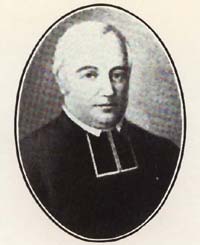 |
|
| Father
Paul Loup Archambault |
The Bishop wrote a letter to Fr. Archambault, giving him permission to prepare some women of good will to live under a common rule, and to teach girls and boys. Esther gathered together six women from Vaudreuil who were willing to try out the new community. On September 4, 1848, they entered on a retreat under the direction of Fr. Archambault, who joined the duty of being their chaplain to that of his parochial work. With the approval of the Bishop, he drew up a temporary rule of life for the retreatants, and Esther became their Directress; Directress was the title used for many years instead of Superior. That same day, Esther wrote a letter to her old friend, Suzanne Pineault; "I know that like myself, you have always been a nun at heart. Who knows but that God has held this grace of a religious profession in reserve for our middle age, and that our many years of waiting were given us as a preparation for this ultimate end. Would you care to come and see what we are doing, and perhaps decide to stay with us?"
The news filled Suzanne with joy and it re-kindled a hope, which she had long thought beyond realization. Like one freed from banishment, she settled her affairs and hastened to Vaudreuil to give herself and all she possessed to the new undertaking. This time God accepted her and when the day came for the first profession, which made the Sisters of St. Anne an institute in the Catholic Church, Suzanne was one of the five who persevered to take the final step.
The budding community never knew actual want, thanks to a grant from the municipality to be applied to the poor students, the donations of the pastor, and the bounty of a fervent Catholic, Lady Marie-Louise de Lotbiniere-Harwood. She was the daughter and heiress of the French Lord of Lotbiniere, and was married to Robert Unwin Harwood, who occupied many important political and governmental offices. Many of the financial burdens of the community were lightened. However, strict economy prevailed, and for a long time, beets, beets, and more beets were the main staple of the community—beet pies, beet soup; beets; mashed, boiled and fricasseed.
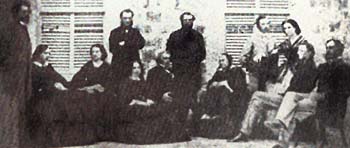 |
| The
Lotbiniere-Harwood Family |
New Superiors
The Bishop came to visit the convent on May 25, 1849. He spent two days there not only giving conferences to the sisters, but he entered into great detail regarding their study periods and teaching methods. He also made appointments—Angele Lefebvre, Directress, Esther Blondin, relieved of school duties, in the busy office of procurator; Suzanne Pineault, assisted by Julienne Ladouceur and Justine Poirier, teachers. Yes, the Bishop gave a secondary position to Miss Blondin, the originator of the great work ahead. Let us not forget this seemingly insignificant incident; it will throw light on what is to come.
The summer vacation of 1849 had just begun when Vaudreuil was ravaged by an epidemic of typhoid. The church bell often tolled for the dead; some of whom were dear to the sisters. And to make matters worse, the sisters were not allowed to visit the plague-stricken. Then one day after the plague had spent itself, and houses were being disinfected, a rowboat was seen approaching the shore. The auxiliary Bishop of Montreal had come to give his sympathies to the pastor and the citizens of Vaudreuil, and to conduct an eight day retreat for the Postulants of the new community—preparatory to their taking the holy habit.
At the end of the retreat the auxiliary Bishop said to the pastor, "I believe we are doing God's work—they are all saints!" The retreat closed on the feast of the Assumption, and nine Postulants received the holy habit. Twelve priests also joined in the ceremony of the new community; and eight new applicants received the Postulant veil.
Before leaving, the Bishop named Sr. Mary Elizabeth as Directress. She occupied the position for a few months only and then returned to the world. The pastor then chose Sr. Mary of the Nativity as the next Directress and for the time being, Sr. Mary Anne was removed from the limelight. The spiritually wise pastor was leading Sr. Mary Anne up Mount Calvary, which she would climb until she reached the top; at the end of her life.
Esther accepted God's will humbly and silently, seeing three Novices about half her age, preferred to her as Directress—and that in the space of one year! She continued under these young Superiors, to discharge with fervor, her offices of procurator, Mistress of Postulants and School Supervisor.
A Great Bishop as Guide
On September 3, 1850, Bishop Bourget arrived in Vaudreuil to give a retreat to the first five Novices who were now ready to make their profession. During the retreat, the saintly Bishop left nothing undone—he instilled the rudiments of perfection in the hearts of these nuns. Above all he insisted on meditation, examination of conscience, sanctifying all their actions, and living in a spirit of faith.
The Novices received their veil on Sunday September 8, 1850. The Bishop wished the ceremony of profession to be performed with all possible solemnity and in the presence of the congregation assembled in the church. His motive was twofold—to edify the parishioners and to enlist their favor towards the new community of religious.
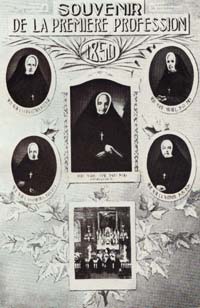 |
|
| The
First Profession |
After the sisters made their profession and assisted at the Holy Sacrifice of the Mass, Bishop Bourget approached the altar of Our Lady to say the Act of Consecration in her honor. Then the nuns returned to their convent where they had an elegant dinner, with servers to boot; thanks to good Lady Harwood. Recreation was enjoyed until 3:00, when Benediction of the Blessed Sacrament was given, after which the guests left and the sisters resumed their retreat, which continued until September 10th. On that day his Excellency made the following community appointments: Mother Mary Anne—Directress and Novice Mistress, Mother Mary of the Conception—Assistant and Sub-Mistress of Novices, Mother Mary of the Assumption—procurator, Mother Mary of the Nativity—cook, and Mother Mary Michael—teacher.
The Bishop ruled that elections would be held every three years and after going back to Montreal, he continued to watch over his little flock in Vaudreuil. The Sisters of St. Anne were now canonically established and Mother Mary Anne was 41 years old.
Each of the five foundresses, whether young or old, was worthy of her position—each proved to be a strong pillar of the Community of the Sisters of St. Anne. In joined faith, humility, prayer, work, and steadfastness, they followed the path of holiness for themselves and led the way for those who followed in their footsteps.
Bishop Bourget continued to be the guide and consolation of the young community. On December 20, 1850, he wrote to Mother Mary Anne expressing his regret that Fr. Chevigny, who substituted for Fr. Archambault, as chaplain and parish priest, could not continue these double duties. The Prelate asked the sisters to, "Pray fervently, that the right person may drop from the clouds with refreshing dew, to fertilize the community." The holy Prelate wrote again in January, 1851 and gave his blessing to his "dear daughters", as he lovingly called the Sisters of St. Anne.
The Bishop went to visit the good sisters for a few days in February, 1851. Gentle in voice and manner, he explained,"… to produce fruits of benediction, you must live in humility and die to self. No doubt it will cost you something to be forgotten, and trodden upon like the nut from which the great tree springs, but it is precisely through humiliation, generously accepted, that you will become worthy of the divine complacency…"
"Believe that the present and future stability of your order depends on your generosity. Sacrifice yourself for it without ceasing. Endeavor day and night by your practice of every virtue to make the foundations secure. The more you suffer for love of it, the richer will it grow in grace and benediction."
Encouraging the nuns to choose the "better part" like St. Mary Magdalene, the Bishop also encouraged the sisters to be active like St. Martha, telling them, "Take great care of the children confided to you. Guard their innocence. Form their young hearts in the fear of the Lord, which is the beginning of wisdom. Believe that in devoting yourselves zealously to their education, you will acquire the science of the saints. … Teach children to sanctify their actions. Cultivate in them the devotions suited to their age. Rear them as St. Anne did Mary. All is said in that."
Later in September, 1851, the Sisters of St. Anne were asked to open a convent in St. Genevieve, a prosperous parish in Montreal. Though the community was still so young, three sisters were appointed and sent there, and it prospered well after it had been established.
In 1852, Bishop Bourget encouraged the Sisters of St. Anne, "The community will be happy and perfect if it lives the spirit of Christ. It is what I wish, above all else, for each of its members."
In March, 1853, the holy Bishop wrote to Mother Mary Anne, "All that happens, my good Mother, happens through the will of God, and for our greater good. … Train the Novices well. In fine, be the soul of this new-born little society."
"Continue with your community and the pupils to offer the sacrifice of your sufferings and of your good works for the souls of so many who are on the way of perdition, and for me, also, who have the responsibility of saving them all."
In the past few years, the rule was being written up and clarified, and when it was finally completed, Bishop Bourget asked Mother Mary Anne to explain it to the Novices. They learned the rule well through her efforts and the enlightenment of the Holy Ghost; thus these souls advanced higher and higher on the path of perfection.
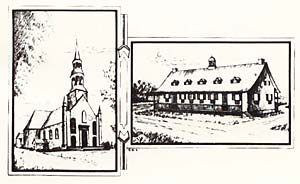 |
| St.
Michael's Church, Vaudreuil (The "Cradle" of the Institute of the S.S.A.) |
Mother Mary Anne needed as much grace and heavenly help
as possible to carry out her double duty of Directress and
Novice-Mistress. These positions entailed the supervision
of personnel, of the classes, of expenses, and of the general
upkeep of the community. Then there was the correspondence,
and parlor calls from priests, friends, and patrons.
It required keen management to make ends meet. True, the donations of the liberal pastor and Lady Harwood filled a gap, but the sisters had to strain every nerve of industry and economy—they were as busy in the fields, as they were in the classroom. On one occasion the sisters who had been busy gathering the potato crop, returned rather late from the field. At dusk, as they approached the convent, they noticed their good Mother on the porch. She had them lay down their sacks of potatoes, refresh themselves, and led them into the refectory where she delighted the sisters, as she served them a hearty meal, which she had prepared herself.
The Community Moves
By 1853, the sisters in Vaudreuil had grown to such an extent that their convent was now much too small for its members. Though Bishop Bourget had asked the people of Vaudreuil, twice, over the past few years, to build a larger convent for the sisters, they had refused. So on August 23, 1853, the Sisters of St. Anne moved to St. Jacques, a village approximately forty miles from Montreal, to occupy the former convent of the Sisters of the Sacred Heart. There had been several delays : waiting seven days for the steamboat to come, then sometime after boarding the boat, it struck a barge; breaking the mast, and almost capsizing. After the boat was repaired, a fire broke out on board, causing considerable damage to the sister's freight. But in the end, the boat finally arrived at St. Sulpice, and the hospitable people there, showed up with twenty-two wagons to help the new sisters with their belongings, move to St. Jacques.
The good Sisters of the Sacred Heart had left the chapel suitably provided, which included a magnificent silver monstrance from France. They had also left a grandfather clock in the parlor, and a service of blue porcelain dishes, in the refectory.
Some Troubles
Fr. Barrette, a man of God, and experienced in the direction of religious, became their new pastor, and soon won the confidence of the sisters. On August 30th, seven days after their arrival, the sisters learned that there was a new-comer at the rectory, Fr. Louis Maréchal. On the following Sunday, September 4th, he came to the convent with Fr. Barrette. They were received in the parlor by Mother Mary Anne and her assistant. After some indifferent conversation, Fr. Maréchal introduced himself, saying, "I suppose you know sisters, that the Bishop has appointed me chaplain of the community?", then he showed them his authorization papers.
This information came like a thunderbolt. Taken by surprise, Mother Mary Anne answered, "The Bishop has not informed me of your coming. I have a letter dated August 7th, naming Fr. Barrette as our chaplain. I shall await further advice from his Lordship, before receiving you as our chaplain." That very day our saint wrote to Bishop Bourget. He answered her saying; "Rev. Fr. Barrette is named pastor of St. Liguori. By this fact you should conclude that he is no longer your chaplain. You should have received the Rev. Fr. Maréchal cordially, since he came in the name of God, made known by the voice of the Bishop. Impress upon your daughters that religious simplicity requires of them to place their confidence in the new-comer, since he comes in the name of Jesus Christ, represented by the Bishop."
After a retreat in September, Mother Mary Anne wrote her filial submission to the Bishop. This act of submission by the Directress, and its kind recognition by the Bishop, should have restored perfect peace in the community, but it did not. Some of the nuns favored Fr. Barrette, and others Fr. Maréchal, and to make maters worse, this atmosphere of unrest continued during the school year.
Since the Sisters of St. Anne had arrived in St Jacques, they busied themselves making plans for a school and working with the workmen, making new partitions and rooms for the opening of classes in the fall. The sisters nailed the laths for the new partitions, then during the night they removed the rubbish and plaster from the demolished walls. In the daytime they waited on the laborers, and did the farm chores. On October 1st, everything was ready for the opening of classes.
Fr. Maréchal was over zealous and had never known an ache or pain, so he could not understand the genuine sufferings of others. One day he ordered three sick nuns in the infirmary to get up and go about their work. Sometime later the chaplain himself suffered an attack of inflammatory rheumatism—he was in pain. Then he humbly admitted to the sisters, "Forgive me. I did not know what real pain is. God has made me understand it!" Nevertheless, God permitted, for Sr. Mary Ann’s own sanctification, that Fr. Maréchal would not like her, and would have a poor opinion of her. She recognized the disdain, in which Fr. Maréchal held her; she repeatedly tried to bring reconciliation to their relationship and she never held any grudge against him. This was hard to do, especially in the face of all the problems our saint encountered, but with God's grace, she conquered and won. She became a living example of humility and obedience because she used these crosses as stepping stones to heaven; they indeed were used to pave her road to sanctity.
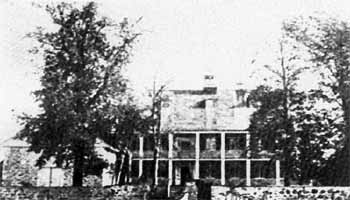 |
| First
Convent of St. Jacques |
The Elections
On July 29, 1854, Bishop Bourget paid his first visit to the sisters at St. Jacques. He officiated at the ceremony of Clothing and Profession and the next day he interviewed a number of sisters. On August 18th, he wrote a letter to Mother Mary Anne, asking the sisters to pray for the coming elections. He continues, "As for you, my good Mother, you will with good heart resign willingly, and you will tell your sisters that you are authorized, never again to accept the superiorship, even if they wish you to assume it!" Esther accepted the new obedience very humbly. She wrote the Bishop, "…At last I am freed from the onerous weight of responsibility. I pity beforehand the sister on whose shoulders it will be laid. …I hope that the sister who will succeed me in office will discharge her duties better than mine. …"
On August 30th, the Bishop came to conduct the elections. Choosing whom he thought best to become the new General Superior, and to fill the positions in St. Jacques, he then appointed Mother Mary Anne; Directress, at St. Geneviève. When our saint arrived at her new post, she suffered much. During the night the heart broken Foundress was often heard weeping. But during the day she carried on in her angelic manner, busying herself with the government of the household.
At St. Geneviève, Mother Mary Anne spent a period of four years and there she again proved her administrative ability. She lifted the convent from debt, and her supervision of the classes won for the teachers and the pupils, the good opinion of the villagers and trustees. In 1857, the new Superior at St. Jacques, begged our saint to give their community, monetary assistance. But the community at St. Geneviève was barely keeping its head above water, so Mother Mary Anne had to refuse help, as often as she was asked.
New Foundations
In time, the sufferings and prayers of Mother Mary Anne mingled with the prayers and sufferings of all the other Sisters of St. Anne, bore fruit. In 1855, a convent was opened at St. Ambrose of Kildare; and in 1857, another was opened in St. Cyprien of Napierville.
In 1858, the Superior General at St. Jacques, removed Mother Mary Anne from St. Geneviève and recalled her to the Motherhouse; there, to perform the task of sacristan and wardrobe keeper. Here our saint paid strict attention to the little things which make up perfection; the chapel shone with cleanliness, the linen was spotless, and the habits of the sisters fitted carefully. She exacted perfection of those who helped her around the altar and had this maxim, "Every act of worship, even the least, should be performed with precision."
At this time, the Sisters of St. Anne were opening a community on Vancouver Island. Our friend volunteered but the Bishop refused her permission. Instead, her community sent her to the isolated wilderness of St. Ambrose de Kildare, about seventy-five miles north of Montreal. She received no assignment, but was simply removed to a remote place!
Obedience, Humility, Charity
When the Motherhouse was moved to Lachine, near Montreal, in 1864, Mother Mary Anne was assigned there. From the time she went to Lachine until five years before her death in 1890, she filled the office of sacristan, and took care of the vestments and linens. An exception was during the school year, 1865-66, when she was Directress of the convent at St. Geneviève.
The sisters, who lived with our friend over the next twenty-four years, revered her regularity, the perfection with which she did even the least action and the recollected dignity of her every movement. When our saint would see someone carrying a burden, she offered assistance, even if it were the youngest sister. Of the Postulants and Novices, Mother Mary Anne often said, "Let us love these dear ones; they are the hope of the community." When she would admonish them for infractions of the rule, it was always with great charity and according to the spirit of the gospel.
In the Motherhouse basement laundry room, in Lachine, where our saint spent her latter days, many generations of Novices and Postulants, received from the foundress, a true example of obedience, humility and charity.
Here are a few of the maxims that Mother Mary Anne loved to live by, and which she used to teach the Novices and Postulants who worked with her in the laundry room and the ironing room.: "God first; God above all; God alone." "Every religious should be a saint." "If God be with us in time, we shall be with Him in eternity." "Do all for God, and this all, should be well done." And our saint loved to say, "Crosses are the warp and woof of life. God destines very heavy ones for certain religious, but never without wrapping them in His love. With them He gives the assurance that the better they are borne, the richer will be their reward."
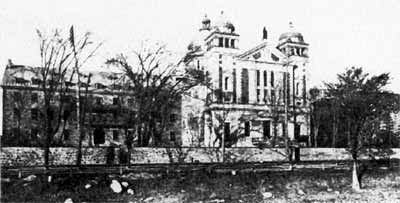 |
| Convent
and Boarding School at Lachine |
Last Years
The last five years of Mother Mary Anne's life was spent working in the infirmary. Though suffering from rheumatism and arthritis, she also kept herself busy with her needle. Though she never wore glasses, her embroidery, her drawn work and her hem stitching were so perfect, that much of it has been preserved and displayed on various occasions. Her politeness towards the sick was charming. She would visit them during noon recreation, and while arranging their pillows and attending to their general comfort, she would tactfully give them some opportune advice and encouragement.
In December 1899, the erection of the chapel of St. Anne was nearing completion, and our saint's end was approaching. Bronchial trouble, which caused incessant coughing was added to her other illnesses. On Christmas Day, our saint heard six Masses and spent the greater part of the day, praying in the new chapel. Owing to the dampness she caught a cold and hence, fever and dyspnoea, soon set in. On New Year's Day, the Novices and Postulants, on whom she had always poured a wealth of affection, entered the room and filed past her bed. She held out her hands to the visitors and blessed them with words, broken by the effort to breathe : "Happy New Year! Be good Religious! Little sisters, you are the future of the Community."
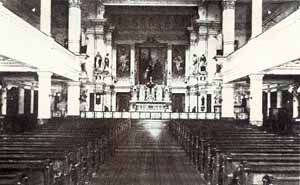 |
| Sanctuary
of St. Anne, Lachine |
Mother Mary Anne lived persecution by forgiving without restriction, convinced that there is "more happiness in forgiving than in revenge." Our saint bequeathed a golden rule to her daughters, saying, "May the Eucharist and surrender to the will of God, be your heaven on earth." Later, at 2:00 in the afternoon, she passed on to her heavenly reward.
In all events, Esther always sought to do God's will. After having been demoted from her position as Mother Foundress, she chose to obey her Bishop, so that her community might live. Deprived of her most legitimate rights, she was prevented from being called "Mother" by the sisters faithful to her. Nevertheless, our saint did not renounce her mission of being the "spiritual mother" of her Community. She offered herself to God in order to expiate all the sins which were committed by the Community, and she prayed daily to good St. Anne "to bestow upon her spiritual daughters the necessary virtues to be educators of the Christian youth."
 |
Witnesses testify that Mother Mary Anne always spoke the truth, without rancor. She trusted Bishop Bourget, even though he had withdrawn his trust of her. The Sisters of St. Anne bore much fruit, and by 1939, they numbered 2000. Today they spread out through Canada, the United States, Haiti, Chile and Cameron. Many students can thank Mother Mary Anne for her saintly efforts to raise up God fearing nuns who became excellent teachers; by word, and by example.
Pope John Paul II declared Mother Mary Anne: Venerable, on May 14, 1991, and Blessed, on April 29, 2001. ←
Blessed Mary Anne Blondin
Pray for Us!
NB: The school established in 1858 in Victoria, BC, by the Sisters of St. Anne, still exists, and has become a museum. (See Picture at right).
From 1871 to 1910 the sisters built a bigger school called St. Ann’s Academy. Since 1974, this magnificent building houses Governmental Offices and an interpretation center. Interestingly enough, the Academy’s Chapel is used monthly for the celebration of the St. Pius V Mass in Latin. Surprised? Not so much, when you will learn that it is said by Rev. Fr. Greuter, a friend of the SSPX! Yes! This is exactly true!



